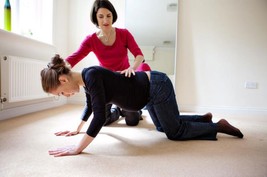
The Alexander Technique (AT) is a pioneering method by which to engage with a person’s often limiting habits that might cause problems for health and wellbeing. F. M. Alexander (1869 – 1955) based his physical contact work on theoretical considerations. 100 years on, practitioners of the Alexander Technique still apply the method as it is handed down through three years full time training. What has become of interest is to understand why the method works.
1. The Angle of Physical Contact Work
The Alexander Technique (AT) is a pioneering method by which to engage with a person’s often limiting habits that might cause problems for health and wellbeing. F. M. Alexander (1869 – 1955) based his physical contact work on theoretical considerations. 100 years on, practitioners of the Alexander Technique still apply the method as it is handed down through three years full time training. What has become of interest is to understand why the method works. In this brief article I outline the angles of the Alexander Technique and pair them up with theories and scientific evidence from other disciplines. AT is to be understood as re-education rather than therapy. F. M. Alexander’s humanistic stance was that we all are a psycho-physical self, that means body and mind are inseparable. He developed four major concepts: 1. Inhibition, meaning the ability to not immediately react to a stimulus in order to not disturb the 2. Primary Control, meaning the innate capacity of human beings to stay well when challenged 3. Directions, meaning the conscious connecting processes between body and mind in order to allow the best possible psycho-physical attitude in every moment of life 4. False Sensory Perception, meaning that humans have a particular perception of something and live accordingly, developing matching habits, emotional and physical armour, often to the detriment of their health and wellbeing and certainly to the detriment of their innate power of spontaneous and creative responses to stimuli. AT provides a fine understanding of the physiology of each individual. While there is a general medical understanding of physiology, with AT we engage with the physiology of each individual. Nobody is built symmetrically or as any model in a physiology book. We are constantly changing organisms. However, AT focuses on the importance to create space inside a person so that the body can do what it needs to do. This can only be achieved through a conscious process, engaging physical and emotional literacy. In an AT session, these concepts ground the practical work and have physical correlations: * Physical contact work: The extremely trained hands of an AT practitioner relate both to the practitioner and the client in the session. Science is only at the beginning of understanding haptic (touch based) work . The AT practitioner’s intention is solely to gain information about dysfunctional happenings in the client and to facilitate the client to learn new ways of being and moving that makes dysfunctional happenings obsolete. In an AT session, people remain dressed. * The hands, thoughts and body of the AT practitioner do not intrude the client’s sphere. Instead, the space remains solely the client’s. AT practitioners do not manipulate, inject anything or massage, heal, etc. Rather, the contact work informs the practitioner of the client’s muscle tone, habitual and often limiting thought and physical (over- and/or underdeveloped coping and stress) patterns. F. M. Alexander’s psychological and mechanical understanding of moving in a stress-free way allows people to learn new ways and help them to stay out of the way of unhelpful and often disabling patterns. The concept of directions is applied in a physical way. With connecting to the psycho-physical self a person learns to not compromise her/his natural grace.
Neuroscience and Attachment Theory (Bowlby, 1969) have begun to understand the power of physical touch in relationship with self and other. Research gives an understanding to AT work. The safe, non-manipulative and non-intrusive touch by an AT practitioner will help to release neurotransmitters (chemical substances that are released by our bodies upon stimuli and), such as endorphins, dopamine, oxytocin, and serotonin that enhance wellbeing. In contrast, stress triggers heightened cortisol and adrenalin. All chemicals have their usefulness at times. However, running mainly on cortisol, in babies, is understood to cause long-lasting negative effects (Gerhard, 2003). I understand that the close and yet non-invasive relational physical contact work of AT facilitates the “happy chemicals” to flood. The body feels lighter after a session. People recognise that this is a possible way of being psycho-physically authentic and gradually learn to stay out of their habits by becoming more self-reflective. For babies, an appropriate environment of holding as an important prerequisite for a baby’s healthy development was identified by Winnicot (1965). In my work I understand that in order to be well, a healthy environment is required for adults too. However, agreeing with F. M. Alexander, it is important that people take responsibility for that to happen.
In the AT session, hand-on work is required as a teaching tool since the sensory perception of a client and her/his psycho-physical self is usually not very well developed at all. The AT practitioner is required to constantly be self-reflective in order not to inject any additional dysfunctional stimulus to the client. More could be said but it must suffice here to sum up that AT is an educational method that enhances physical, emotional and relational literacy and intelligence that is far reaching. It does not claim to heal or cure anything. The prerequisite for engaging with AT is to bring is curiosity and an acceptance of own responsibility in personal wellbeing. The degree of physical ability is secondary since this usually changes towards more freedom. The AT facilitates people to be their best self they can be with whatever they bring. References Bowlby J (1969). Attachment and Loss. London: Tavistock Gerhard S (2003). Why Love Matters. London: Routledge. Winnicot D (1965). The Maturational Processes and the Facilitating Environment. Studies in the Theory of Emotional Development. London: The Hogarth Press Please feel free to email me for further information. Doris Prugel Bennett
0 Comments
Leave a Reply. |
The Holistic Life CoachHolistic & Natural Solutions for Health and Wellbeing Categories
All
Archives
March 2018
|
COOKIE POLICYWe use cookies on this site to help us improve your experience. If you wish to understand fully how we use these, click through for our 'cookie policy'.
PRIVACY POLICY |
disclaimerAll material on this website is provided for your information only and may not be construed as medical advice or instruction. |
Contact UsSubscribeJoin our mailing list today!
|


 RSS Feed
RSS Feed